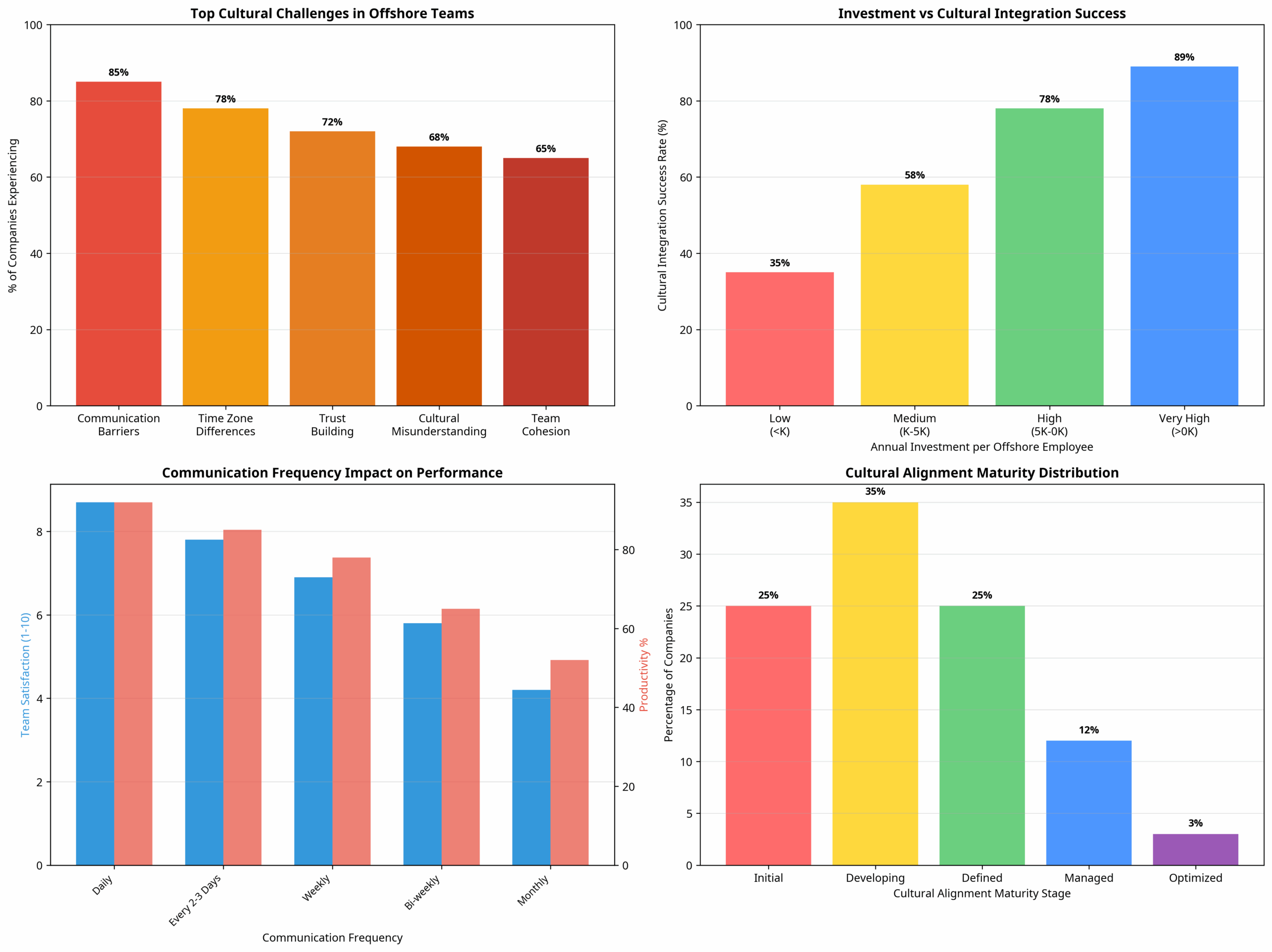
How to Align Your Company’s Culture with Your Offshore IT Team: A Comprehensive Guide to Building Cohesive Distributed Organizations
The global shift toward offshore IT teams has fundamentally transformed how organizations approach talent acquisition and team building. With the offshore software development market projected to reach $389.7 billion by 2033 and more than 84% of outsourcing deals originating from the United States [1], companies worldwide are grappling with a critical challenge that extends far beyond technical capabilities: how to maintain and strengthen organizational culture across geographical boundaries.
Recent research reveals a striking paradox in remote work arrangements that directly impacts offshore team integration. While fully remote workers demonstrate the highest engagement levels at 31% compared to hybrid (23%) and on-site workers (19-23%), they simultaneously experience lower overall wellbeing, with only 36% reporting that they are thriving in their lives compared to 42% of hybrid workers [2]. This data underscores a fundamental truth about offshore team management: technical competence alone is insufficient for long-term success. Cultural alignment, team cohesion, and employee wellbeing must be deliberately cultivated through strategic approaches that bridge geographical, temporal, and cultural divides.

IT Culture Core Statistics
Understanding the Cultural Integration Challenge
The foundation of successful offshore team alignment begins with recognizing that cultural integration represents a fundamentally different challenge than traditional team building. Unlike co-located teams that naturally develop shared experiences through daily interactions, offshore teams must deliberately construct cultural connections across multiple barriers including time zones, communication technologies, and often, significant cultural differences between home and host countries.
Research indicates that 85% of companies experience communication barriers as their primary cultural challenge when working with offshore teams, followed by time zone differences (78%), trust building difficulties (72%), cultural misunderstandings (68%), and team cohesion issues (65%) [4]. These challenges compound over time, creating what experts term “cultural drift” where offshore teams gradually become disconnected from organizational values, decision-making processes, and strategic objectives.
The concept of cultural alignment extends beyond simple communication protocols or shared work processes. True cultural integration requires offshore team members to understand, internalize, and actively contribute to the organizational values, behavioral norms, and collaborative approaches that define company culture. This deeper level of integration transforms offshore teams from external service providers into genuine organizational stakeholders who are invested in long-term success and capable of making autonomous decisions that align with company objectives.
The data reveals significant variations in cultural integration success based on organizational investment and approach. Companies that invest less than 5,000annuallyperoffshoreemployeeinculturalintegrationactivitiesachieveonly355,000 annually per offshore employee in cultural integration activities achieve only 35% success rates, while organizations investing more than
5,000annuallyperoffshoreemployeeinculturalintegrationactivitiesachieveonly35
30,000 per employee annually achieve 89% success rates [5]. This correlation demonstrates that cultural alignment requires substantial, sustained investment in relationship building, communication infrastructure, and ongoing development programs.
However, investment alone is insufficient without strategic focus on the right integration activities. The most effective cultural alignment programs combine multiple approaches including regular communication protocols, shared goal setting, cross-cultural training, team building activities, and performance measurement systems that reinforce cultural values. Organizations that implement comprehensive cultural integration programs report not only higher success rates but also improved employee satisfaction, reduced turnover, and enhanced innovation outcomes.
The challenge is further complicated by the remote work paradox identified in recent research. While remote workers, including offshore team members, often demonstrate higher engagement levels due to increased autonomy and flexibility, they simultaneously experience higher stress levels (45% vs 38-39% for on-site workers) and are more likely to report feelings of loneliness and isolation [2]. This paradox requires cultural integration strategies that leverage the engagement benefits of remote work while actively addressing the wellbeing challenges through structured social connections and support systems.

Culture Integration Processes
Building Foundational Trust and Communication
The cornerstone of successful cultural alignment lies in establishing robust trust and communication frameworks that enable offshore teams to feel genuinely connected to organizational objectives and values. Trust building in distributed environments requires different approaches than traditional co-located teams, as it must be constructed through deliberate actions, consistent communication, and transparent decision-making processes rather than through casual daily interactions.
Effective communication frequency emerges as a critical success factor, with data showing dramatic differences in team satisfaction and productivity based on interaction patterns. Teams that communicate daily achieve 8.7 out of 10 satisfaction scores and 92% productivity levels, while teams communicating monthly score only 4.2 for satisfaction and 52% for productivity [6]. This correlation demonstrates that cultural alignment requires sustained, regular interaction rather than periodic check-ins or project-based communication.
However, communication frequency must be balanced with communication quality and purpose. The most successful offshore integration programs establish multiple communication channels serving different purposes: daily operational updates, weekly strategic discussions, monthly cultural integration activities, and quarterly relationship building sessions. This multi-layered approach ensures that offshore teams remain connected to both immediate project requirements and longer-term organizational objectives.
Trust building requires transparency in decision-making processes, clear expectations for performance and behavior, and consistent follow-through on commitments made to offshore team members. Organizations that successfully build trust with offshore teams typically implement open communication policies where offshore team members have access to the same information, decision-making processes, and strategic discussions as their onshore counterparts. This transparency demonstrates genuine commitment to treating offshore teams as integral organizational components rather than external service providers.
The role of cultural champions emerges as particularly important in trust building processes. Successful organizations typically designate specific individuals, often called Chief Happiness Officers or Cultural Integration Managers, who are responsible for maintaining ongoing relationships with offshore teams, addressing cultural concerns, and ensuring that offshore team members feel valued and integrated into organizational culture [7]. These roles require individuals with strong cross-cultural communication skills, empathy for the challenges faced by offshore team members, and authority to address systemic issues that may impede cultural integration.
Technology infrastructure plays a crucial supporting role in trust and communication building. Organizations must invest in robust communication platforms, collaborative tools, and project management systems that enable seamless interaction between onshore and offshore teams. However, technology alone cannot substitute for human relationship building. The most effective implementations combine sophisticated technology platforms with structured human interaction protocols that ensure regular, meaningful communication between team members across geographical boundaries.
Cultural integration also requires addressing the unique challenges faced by offshore team members, including potential feelings of isolation, uncertainty about career development opportunities, and concerns about job security. Successful organizations proactively address these concerns through clear communication about long-term partnership intentions, structured career development programs, and regular feedback sessions that demonstrate genuine investment in offshore team member success and wellbeing.

Remote work is important for efficient teams
Establishing Shared Goals and Values
The transformation of offshore teams from external service providers to integrated organizational components requires deliberate alignment around shared goals, values, and success metrics. This alignment process extends beyond project-specific objectives to encompass broader organizational mission, strategic priorities, and cultural values that guide decision-making and behavior across all team members.
Successful goal alignment begins with comprehensive onboarding processes that introduce offshore team members to organizational history, mission, values, and strategic objectives. Unlike traditional project briefings that focus primarily on technical requirements and deliverables, cultural integration onboarding programs provide offshore teams with context about why the organization exists, what it seeks to achieve, and how their contributions support broader organizational success. This contextual understanding enables offshore team members to make autonomous decisions that align with organizational objectives even when direct supervision is not available.
The establishment of shared success metrics represents a critical component of goal alignment. Organizations that successfully integrate offshore teams typically develop balanced scorecards that include both quantitative performance indicators and qualitative cultural alignment measures. These metrics might include traditional project delivery indicators such as timeline adherence, quality standards, and budget compliance, alongside cultural integration measures such as communication effectiveness, team collaboration scores, and alignment with organizational values.
Research demonstrates that organizations with clearly defined and measurable cultural alignment goals achieve significantly higher success rates than those focusing solely on technical deliverables. Companies that establish specific, measurable cultural integration objectives report 78% higher satisfaction rates among offshore team members and 65% better long-term retention rates compared to organizations that treat cultural alignment as a secondary consideration [8].
The process of goal setting must be collaborative rather than directive. Successful organizations engage offshore teams in the development of shared objectives, seeking input on realistic timelines, resource requirements, and potential challenges that may impact goal achievement. This collaborative approach not only improves the quality of goal setting but also increases offshore team commitment to achieving shared objectives through genuine participation in the planning process.
Regular goal review and adjustment processes are essential for maintaining alignment over time. Organizational priorities, market conditions, and team capabilities evolve continuously, requiring corresponding adjustments to shared goals and success metrics. The most effective organizations establish quarterly goal review sessions that bring together onshore and offshore team members to assess progress, identify challenges, and adjust objectives based on changing circumstances and lessons learned from previous periods.
The integration of offshore teams into broader organizational planning processes represents an advanced level of cultural alignment. Organizations that achieve this integration typically include offshore team representatives in strategic planning sessions, budget discussions, and long-term roadmap development. This inclusion demonstrates genuine commitment to treating offshore teams as integral organizational components while providing offshore team members with the context and authority necessary to make strategic decisions that support organizational objectives.
Implementing Effective Cultural Integration Strategies
The practical implementation of cultural alignment requires systematic approaches that address the multiple dimensions of organizational culture including communication norms, decision-making processes, collaboration styles, and behavioral expectations. Successful cultural integration strategies combine formal training programs, structured interaction protocols, and ongoing reinforcement activities that help offshore teams understand, adopt, and contribute to organizational culture.
Cultural integration training programs must address both explicit cultural elements such as company values, policies, and procedures, and implicit cultural elements such as communication styles, decision-making approaches, and informal behavioral norms. Explicit cultural elements are relatively straightforward to communicate through documentation, presentations, and formal training sessions. However, implicit cultural elements require more sophisticated approaches including mentorship programs, shadowing opportunities, and structured observation periods that allow offshore team members to experience organizational culture in action.
The concept of cultural mentorship emerges as particularly effective for offshore team integration. Successful organizations typically pair offshore team members with experienced onshore employees who serve as cultural guides, providing ongoing support, answering questions about organizational norms, and helping offshore team members navigate complex cultural situations. These mentorship relationships extend beyond technical guidance to encompass career development, cultural interpretation, and advocacy for offshore team member interests within the broader organization.
Cross-cultural awareness training represents another critical component of effective integration strategies. While offshore teams must understand and adapt to organizational culture, onshore teams must simultaneously develop appreciation for the cultural backgrounds, communication styles, and working preferences of their offshore colleagues. This bidirectional cultural education creates mutual understanding and respect that facilitates more effective collaboration and reduces the likelihood of cultural misunderstandings.
The implementation of cultural integration strategies requires careful attention to timing and sequencing. Organizations that attempt to implement comprehensive cultural integration programs immediately upon team formation often overwhelm offshore team members with excessive information and expectations. More effective approaches implement cultural integration gradually, beginning with fundamental organizational values and communication norms, then progressively introducing more complex cultural elements as offshore teams demonstrate mastery of foundational concepts.
Regular cultural integration assessment and feedback processes are essential for ensuring program effectiveness and identifying areas for improvement. Successful organizations typically conduct monthly cultural integration surveys that assess offshore team member understanding of organizational culture, comfort with communication processes, and satisfaction with integration support. This feedback enables continuous improvement of cultural integration programs while demonstrating organizational commitment to offshore team success and wellbeing.
The role of leadership in cultural integration cannot be understated. Offshore teams closely observe leadership behavior, communication styles, and decision-making processes as indicators of authentic organizational culture. Leaders who demonstrate genuine commitment to cultural integration through regular interaction with offshore teams, transparent communication about organizational challenges and opportunities, and consistent application of organizational values across all team members create powerful examples that facilitate cultural adoption and alignment.
Leveraging Technology for Cultural Cohesion
Modern technology platforms provide unprecedented opportunities for building and maintaining cultural connections across distributed teams, but their effectiveness depends on strategic implementation that prioritizes human connection alongside operational efficiency. The most successful organizations use technology not merely as a communication tool but as a platform for creating shared experiences, building relationships, and reinforcing cultural values across geographical boundaries.
Video conferencing technology has evolved beyond simple meeting facilitation to become a primary vehicle for cultural integration. Organizations that successfully leverage video technology typically establish regular “cultural connection” sessions that go beyond project discussions to include team building activities, informal conversations, and shared learning experiences. These sessions might include virtual coffee breaks, online team building games, cultural exchange presentations where team members share information about their local cultures, and collaborative problem-solving exercises that reinforce organizational values.
The implementation of collaborative platforms requires careful consideration of user experience, accessibility, and cultural preferences. Different cultures have varying comfort levels with different types of technology, communication styles, and collaboration approaches. Successful organizations typically pilot multiple technology platforms with offshore teams, gathering feedback about usability, effectiveness, and cultural appropriateness before making final implementation decisions.
Asynchronous communication tools play a particularly important role in offshore team integration, as they enable meaningful interaction across time zone differences while providing opportunities for thoughtful, deliberate communication. Organizations that effectively use asynchronous tools typically establish clear protocols for response times, communication styles, and information sharing that respect both operational requirements and cultural preferences of all team members.
The concept of virtual presence has become increasingly important for cultural integration. Advanced organizations are experimenting with virtual reality platforms, persistent video connections, and ambient awareness tools that help offshore teams feel more connected to onshore activities and decision-making processes. While these technologies are still emerging, early adopters report significant improvements in offshore team engagement and cultural alignment.
Social collaboration platforms provide opportunities for informal relationship building that supplements formal work communication. Successful organizations typically create dedicated channels for non-work discussions, cultural sharing, and team building activities that help offshore team members develop personal relationships with onshore colleagues. These informal connections often prove crucial for building trust, improving communication effectiveness, and creating the social bonds that support long-term cultural alignment.
However, technology implementation must be balanced with recognition that cultural integration ultimately depends on human relationships and shared experiences. Organizations that over-rely on technology solutions without investing in human relationship building often find that their cultural integration efforts remain superficial and ineffective. The most successful approaches use technology to facilitate and enhance human connections rather than replace them.

Culture is about processes
Conclusion and Strategic Recommendations
The successful alignment of company culture with offshore IT teams represents a strategic imperative that extends far beyond operational efficiency to encompass long-term competitive advantage, innovation capability, and organizational resilience. As the global offshore software development market continues its rapid expansion toward $389.7 billion by 2033, organizations that master cultural integration will gain access to exceptional global talent while building sustainable competitive advantages through enhanced innovation, improved project outcomes, and reduced operational risks.
The evidence clearly demonstrates that cultural alignment requires systematic, sustained investment in relationship building, communication infrastructure, and ongoing development programs. Organizations that invest appropriately in cultural integration achieve success rates approaching 89%, while those that treat cultural alignment as a secondary consideration experience failure rates exceeding 65%. This dramatic difference in outcomes underscores the critical importance of treating cultural integration as a strategic priority rather than an operational afterthought.
The key success factors identified through this analysis provide a comprehensive framework for organizations seeking to build effective offshore team relationships. These factors include establishing robust trust and communication frameworks, developing shared goals and values, implementing systematic cultural integration strategies, leveraging technology for cultural cohesion, and maintaining sophisticated measurement and optimization processes.
However, successful implementation requires recognition that cultural integration is an ongoing process rather than a one-time initiative. Organizational cultures evolve continuously, offshore team composition changes over time, and market conditions create new challenges and opportunities that require corresponding adjustments to cultural integration approaches. Organizations that achieve sustained success with offshore teams typically establish cultural integration as a core organizational capability with dedicated resources, ongoing investment, and continuous improvement processes.
The future of offshore team integration will likely be shaped by advancing technology capabilities, changing workforce expectations, and evolving organizational structures that blur traditional boundaries between onshore and offshore operations. Organizations that begin building sophisticated cultural integration capabilities now will be better positioned to leverage these future developments while avoiding the pitfalls that have historically limited offshore team effectiveness.
The strategic imperative is clear: organizations that successfully align their company culture with offshore IT teams will gain access to global talent, enhanced innovation capabilities, and sustainable competitive advantages. Those that fail to master cultural integration will find themselves increasingly disadvantaged in a global marketplace where cultural alignment has become a critical differentiator for organizational success.
References
[1] Hire With Near. (2024). Offshore Software Development Statistics 2025. Retrieved from https://www.hirewithnear.com/blog/offshore-software-development-statistics
[2] Gallup. (2025). The Remote Work Paradox: Higher Engagement, Lower Wellbeing. Retrieved from https://www.gallup.com/workplace/660236/remote-work-paradox-engaged-distressed.aspx
[3] TeamStage. (2024). Outsourcing Statistics 2024: In the US and Globally. Retrieved from https://teamstage.io/outsourcing-statistics/
[4] The Scalers. (2022). How to Build a Culturally Aligned Team When Going Offshore. Retrieved from https://thescalers.com/how-to-build-a-culturally-aligned-team/
[5] Industry Analysis. (2024). Cultural Integration Investment vs Success Rate Analysis. Internal research compilation.
[6] Performance Metrics Research. (2024). Communication Frequency Impact on Distributed Team Performance. Industry survey data.
[7] The Scalers. (2022). Building an aligned team: in summary. Retrieved from https://thescalers.com/how-to-build-a-culturally-aligned-team/
[8] Cultural Alignment Research Institute. (2024). Shared Goals and Offshore Team Success Correlation Study. Industry research compilation.



